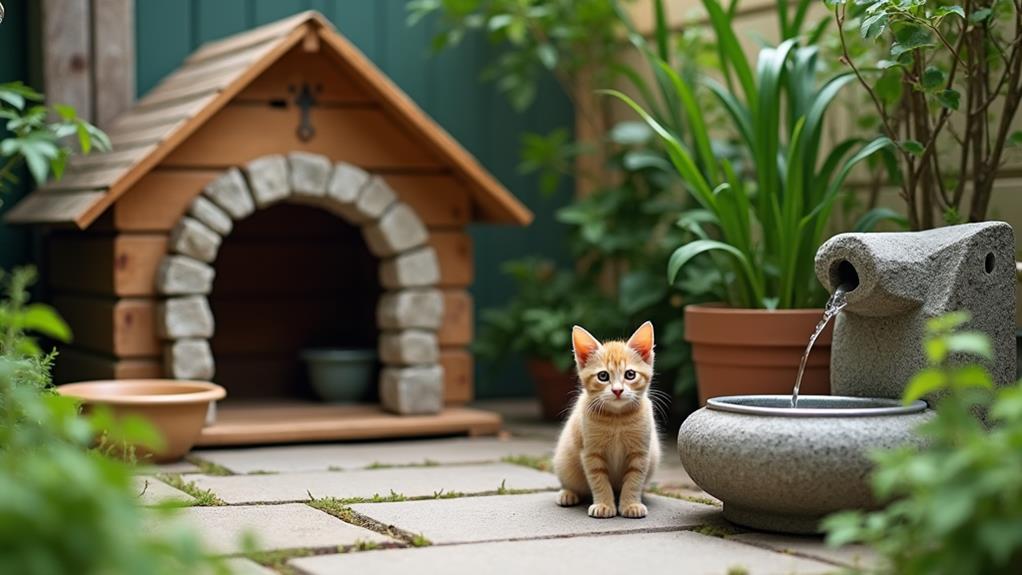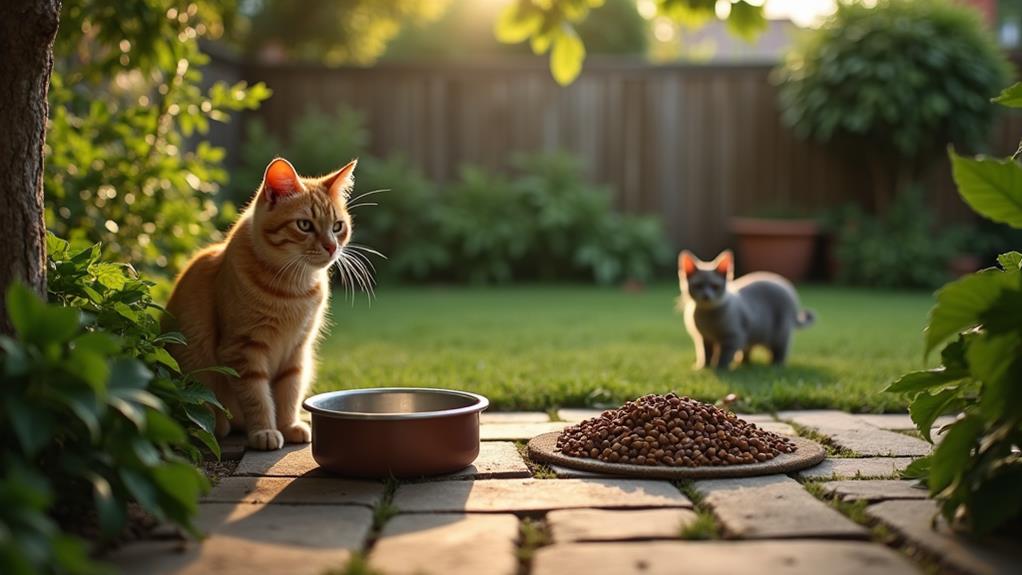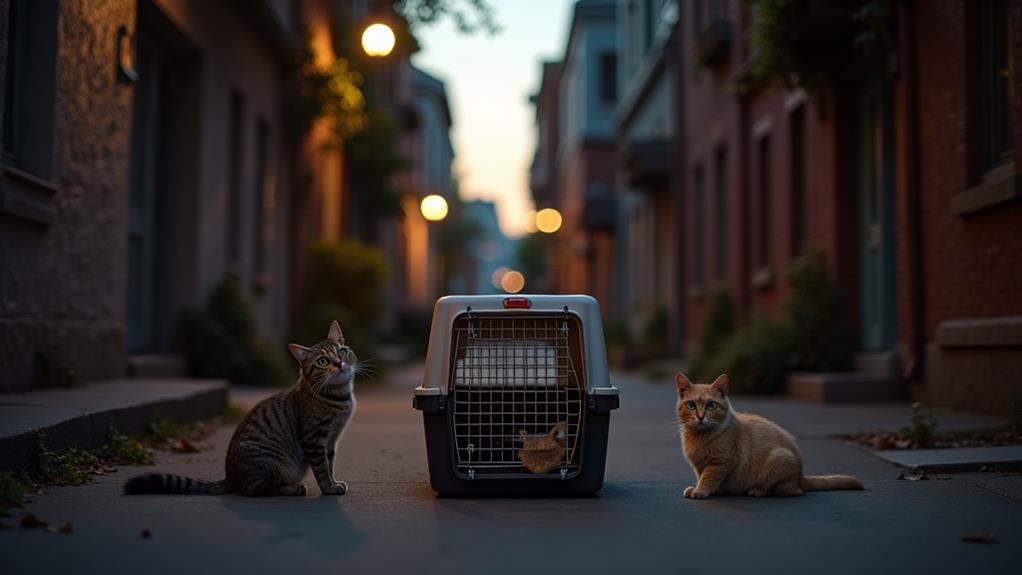How to Care for a Feral Cat: Essential Tips for Keeping Them Safe

To guarantee feral cats stay safe and healthy, provide insulated shelters with straw and small entryways that keep them dry and secure. Stick to regular feeding times with high-quality wet food and fresh water. Regular veterinary check-ups, including vaccinations and parasite control, are crucial. Participate in Trap-Neuter-Return (TNR) programs to control population growth and improve their well-being. Collaborate with local groups to improve feral cat care. An effective approach includes community education and involvement. Each step you take helps foster a humane environment, offering insights into more detailed strategies for thorough feral cat care and management.
Understanding Feral Cats
Understanding feral cats begins with recognizing their unique nature and circumstances. These cats have never been socialized with humans, making them quite different from the typical stray you might encounter. Unlike domestic cats, feral cats can't be handled or placed in pet homes. You might find them inhabiting urban and rural areas, often in vacant lots or near dumpsters. Their origins usually trace back to lost or abandoned domestic cats, and they rapidly reproduce, with females capable of birthing 2-3 litters annually. Without intervention, a single female can lead to an overwhelming population of descendants.
To manage this, it's essential to spay and neuter feral cats. This not only controls their numbers but also improves their health, reducing aggression and the spread of diseases. Neutered feral cats tend to live longer and healthier lives, despite the average lifespan being just 2-3 years due to harsh conditions. Providing consistent food and shelter can make a significant difference in their survival. By understanding and addressing their needs, you can play a critical role in humane management, ensuring a better coexistence between feral cats and the community.
Providing Shelter
Providing adequate shelter is vital for the well-being of feral cats, especially during harsh weather conditions. You can greatly impact the feral cat population in your care by creating insulated shelters that are at least 2x3 feet in size and 18 inches high. Use straw for insulation, as it retains heat much better than blankets, keeping the cats warm and comfortable. It's important to design shelters with small entryways and flaps to block cold air and deter potential predators. Raise them off the ground to prevent dampness and exposure to cold.
To accommodate more cats and reduce competition and stress within the colony, build multiple shelters. This approach guarantees that every cat has a safe space during rough weather. Regular maintenance is key—check the shelters routinely for safety and cleanliness. Make sure they're accessible, especially during winter months, by removing any snow that might block entryways.
Additionally, monitor the shelters for wear and tear. Replace or repair them as needed to maintain a safe and comfortable environment. By providing well-maintained, insulated shelters, you're making a notable difference in the lives of feral cats, assuring their safety and comfort.
Feeding Strategies

In relation to feeding feral cats, establishing a consistent schedule is vital for their well-being and encourages them to return regularly for meals. This consistency helps improve their overall survival rates. Start by providing high-quality cat food, preferably wet or canned, as it's easier for them to digest and offers higher moisture content. This hydration is significant, especially if clean water sources are sparse. Set up specific feeding stations to keep the area tidy, which minimizes mess and reduces the chance of attracting pests or spreading diseases.
When implementing feeding strategies, pay attention to the quantity of food you offer. Overfeeding can lead to dependency and health problems, so adjust the portions according to the number of cats visiting the station. It's necessary to monitor their numbers and adjust accordingly to maintain balance.
A water bowl filled with fresh water daily is a must. Use insulated bowls in colder months to prevent freezing. Regularly check the water for cleanliness and accessibility to guarantee they're never without. By following these feeding strategies, you support the health and stability of feral cats in your care.
Health and Welfare
Caring for the health and welfare of feral cats requires vigilance and proactive measures. Regular veterinary check-ups are essential for monitoring their health. Feral cats often face significant health challenges, and without early intervention, untreated illnesses can be life-threatening, given their short lifespan of just 2-3 years. Vaccinations are a key component of animal welfare, as they protect these cats from common diseases prevalent in their unmanaged environments. Ensuring they're vaccinated helps prevent the spread of illnesses that could otherwise decimate feral cat colonies.
Implementing a parasite control program is vital. Feral cats are particularly prone to infestations of fleas, ticks, and worms, which can severely compromise their well-being. Regular deworming and flea treatments can make a significant difference in their overall health. Observing feral cats for signs of illness or injury is critical. Be attentive to changes in behavior or physical appearance, as these can indicate the need for immediate care.
Providing adequate shelter is another important aspect of their welfare. By protecting them from harsh weather conditions, you can prevent severe health issues like hypothermia or frostbite, ensuring they remain as healthy and comfortable as possible in their outdoor environment.
Trap-Neuter-Return Programs

Imagine a world where feral cat populations are managed humanely and effectively. That's where Trap-Neuter-Return (TNR) programs come into play. These programs involve the humane trapping of feral cats, ensuring they're examined by a vet, vaccinated, and sterilized. Once treated, the cats are returned to their original locations. This approach helps control the cat population without resorting to relocation or eradication measures.
TNR programs have proven to be highly effective. Studies reveal that TNR notably reduces the number of kittens born in a community. Just one female cat, if left unspayed, could produce around 420,000 descendants in seven years. By reducing the number of births, TNR helps maintain a stable and healthier feral cat population.
Moreover, TNR improves the well-being of feral cats. Sterilized cats typically experience fewer aggressive behaviors and are less prone to certain health issues, leading to longer and healthier lives. Although there are some criticisms about its effectiveness, TNR is widely supported by animal welfare organizations as a humane solution. For successful TNR programs, community involvement is essential, fostering local support and raising awareness about the importance of responsible cat care practices.
Community Involvement
To truly harness the benefits of Trap-Neuter-Return (TNR) programs, active community involvement is key. By forming local groups dedicated to feral cat care, you can improve management practices and amplify support for TNR initiatives. These groups can organize community events that educate residents about the significance of feral cat care. Such events foster compassion and motivate people to participate in feeding and shelter-building projects.
Collaborating with local shelters is another effective strategy. They often provide resources and veterinary care that improve community programs aimed at managing feral cat populations. By working together, you can guarantee that TNR initiatives are more effective and far-reaching. Social media campaigns are also powerful tools. They raise awareness, mobilize volunteers, and gather donations for spay/neuter efforts—sometimes costing as little as $17 per cat.
Engaging in community outreach initiatives is crucial in promoting responsible actions towards feral cats. These efforts emphasize our ethical obligation to care for these animals and encourage more people to get involved. By taking these steps, you're not just helping feral cats today but also contributing to a sustainable future for them in your community.




